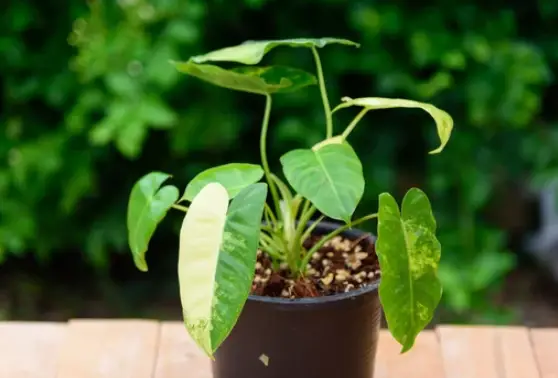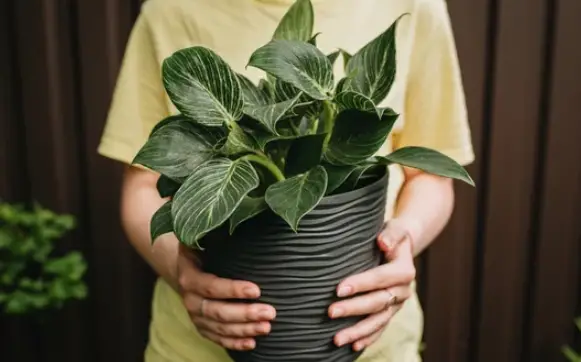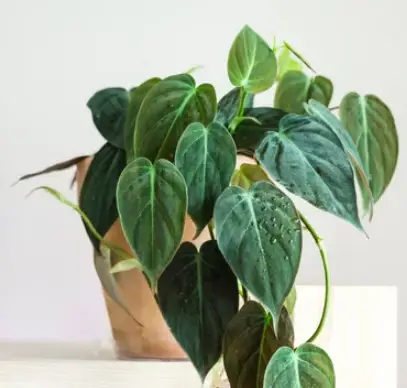If you’re a plant enthusiast looking to add some greenery to your home or office, the philodendron tree might be the perfect choice for you.
Not only are these plants attractive and easy to care for, but they also have a number of benefits, including improving air quality and reducing stress.
In this post about philodendron tree care, we’ll cover everything you need to know to keep your philodendron happy and healthy.
What is a Philodendron Tree?
Philodendron is a large plant family that includes a wide variety of species, from small potted plants to large, tree-like specimens.
One of the most popular types of philodendron is the heartleaf philodendron (Philodendron scandens), which is often grown as a trailing or climbing plant.
These plants are native to the rainforests of Central and South America, where they grow on trees and other tall structures.
The leaves of the heartleaf philodendron are typically dark green and glossy, with a heart-shaped or oval shape.
The plant produces small, green flowers, but they are not particularly showy.
The main attraction of the heartleaf philodendron is its lush, green foliage, which makes it a great choice for adding some greenery to a room.
Other popular types of philodendron include the split-leaf philodendron (Philodendron bipinnatifidum), also known as the Swiss cheese plant, and the elephant ear philodendron (Philodendron domesticum), which has large, heart-shaped leaves that are a deep green color.
Light and Temperature
One of the key factors to consider when caring for a philodendron tree is the amount of light it receives.
These plants prefer bright, indirect light and will thrive in a spot near a window that gets plenty of indirect sunlight.
You should also avoid placing your philodendron tree in direct sunlight, as this can cause the leaves to become scorched or discolored.
When it comes to temperature, philodendron trees are fairly tolerant and can thrive in a wide range of conditions.
They prefer temperatures between 70 and 90 degrees Fahrenheit and can tolerate temperatures as low as 50 degrees Fahrenheit.
Avoid placing your philodendron tree in a location that gets too cold or too hot, as this can cause the plant to become stressed.
Watering
Proper watering is crucial for keeping your philodendron tree healthy.
These plants prefer evenly moist soil, but they don’t like to sit in standing water. To water your philodendron tree, check the soil with your finger or a moisture meter to see if it is dry.
If the top inch or two of soil is dry, it’s time to water. Water the plant until the soil is evenly moist and then let the excess water drain away.
Be sure to empty the drainage tray after watering to prevent the plant from sitting in standing water.
In general, it’s a good idea to water your philodendron tree once or twice a week, depending on the humidity and temperature in your home.
During the winter months, when the plant is not actively growing, you can reduce watering to once every two weeks.
Fertilizing
Like all plants, philodendron trees need nutrients to thrive. You can provide these nutrients by fertilizing your plant on a regular basis.
Use a balanced liquid fertilizer and follow the instructions on the label for the appropriate amount and frequency.
Nevertheless, it’s a good idea to fertilize your philodendron tree once a month during the growing season (spring and summer).
During the winter months, you can reduce fertilizing to once every two months or skip it altogether.
It’s also important to choose the right type of fertilizer for your philodendron tree.
Look for a fertilizer that is high in nitrogen, phosphorus, and potassium, as these are the nutrients that the plant needs most.
Avoid fertilizers that are high in salt, as these can damage the plant’s roots and cause it to become stressed.
Soil and Repotting
Philodendron trees prefer a well-draining soil that is rich in organic matter.
A commercial potting mix that is formulated for houseplants is a good choice, or you can mix your own by combining equal parts peat moss, compost, and perlite.
Nevertheless, it’s a good idea to repot your philodendron tree every two to three years, or whenever the plant becomes pot-bound (when the roots fill the pot and there is no room for them to grow).
When repotting your philodendron tree, choose a pot that is one size larger than the current pot, and be sure to use a fresh potting mix.
Pruning and Grooming
Philodendron trees don’t require a lot of pruning, but you may want to trim off any dead or damaged leaves as needed to keep the plant looking its best.
To prune your philodendron tree, use a pair of clean, sharp scissors or pruning shears and cut the leaf off at the base.
Be sure to sterilize your scissors with rubbing alcohol before and after pruning to prevent the spread of any diseases.
In addition to pruning, you may also want to groom your philodendron tree by wiping the leaves with a damp cloth to remove any dust or dirt.
This will help the plant to photosynthesize more efficiently and stay healthy.
Pests and Diseases
Philodendron trees are generally hardy and resistant to pests and diseases, but they can be prone to certain issues.
One of the most common problems is mealybugs, which are small, white insects that feed on the sap of the plant.
To get rid of mealybugs, you can try wiping the leaves with a solution of water and mild dish soap or using an insecticide specifically formulated for mealybugs.
Another common problem is root rot, which is caused by the plant being overwatered or the soil not draining properly.
To prevent root rot, be sure to water your philodendron tree correctly and choose a well-draining soil.
If you suspect that your plant has root rot, you may need to repot it using fresh soil and trim off any diseased roots.
Things to Know About Philodendron Tree Care

Propagating Philodendron Trees:
Philodendron plants can be propagated by rooting stem cuttings in water or planting them in soil. This is a great way to create new plants and add them to your collection.
Philodendron Tree Varieties:
As mentioned earlier, there are many different species of philodendron, each with its own unique characteristics.
Some popular varieties include the heartleaf philodendron, split-leaf philodendron, elephant ear philodendron, and tree philodendron (Philodendron Bipinnatifidum’ Selloum’).
Philodendron tree toxicities: It’s important to note that some species of philodendron are toxic to humans and pets if ingested.
If you have young children or pets, it’s a good idea to research the specific variety of philodendrons you have and take precautions to keep them out of reach.
Common Problems With Philodendron Trees:
In addition to pests and diseases, there are a few other common problems that can affect philodendron trees.
These include yellowing leaves, which can be caused by too much or too little water, or insufficient light. Brown or crispy leaves can be a sign of over-watering or a pest infestation.
Using philodendron trees in landscaping:
Philodendron plants are not just limited to indoor use, they can also make a beautiful addition to outdoor landscaping.
If you live in a tropical or subtropical climate, you can plant a philodendron tree in your yard and enjoy its lush foliage all year round.
Just be sure to protect it from extreme temperatures and direct sunlight.
Conclusion
Philodendron trees are a beautiful and easy-to-care-for addition to any home or office. By following these simple care instructions, you can keep your plant happy and healthy for years to come.
With a little bit of attention and the right conditions, your philodendron tree will thrive and bring a touch of the rainforest to your space.




